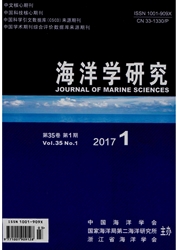

 中文摘要:
中文摘要:
以嵊泗海域为研究区域,研究了该区域大气总悬浮颗粒物(TSP)含量及TSP中重金属含量随季节变化的特征,通过对TSP中各重金属元素的相关系数、富集因子以及气象要素的分析来判断重金属的来源。结果表明:冬季该海域TSP含量最大,为夏季的4倍之多,季节变化很显著;冬季该海域TSP中重金属(Cu、Pb、Cd)含量最高,秋、春季次之,夏季最低。冬季Cu、Pb和Cd含量分别为夏季的17、27和27倍。TSP含量和TSP中的Cu、Pb、Cd含量的相关性不强,或基本不相关;但Cu、Pb、Cd含量之间的相关系数却很大,其中Pb与Cd含量的相关系数达到了0.95,说明它们的关系密切,可能来自同一个源。富集因子由大到小对应的3种重金属依次为Cd、Pb和Cu。从富集因子年平均值来看,Cu、Pb、Cd都被富集;冬季3种重金属都被严重富集,夏季3种重金属都没有被富集。冬季,嵊泗群岛盛行西北风且风速很大,非常有利于把上海及其周边城市的污染物输送到嵊泗海域,造成冬季该海域的TSP中重金属含量严重富集;春季,嵊泗群岛盛行的风向开始转变为东南风,风从海洋吹向大陆,所以春季该海域TSP中重金属含量急剧减少;夏季,嵊泗群岛的风向转变为东风,风还是从海...
 英文摘要:
英文摘要:
Based on the data of the sea area of Shengsi in the East China Sea,seasonal variations of the content of total suspended particles (TSP) and heavy metals were studied. Through the analysis of correlation coefficient and enrichment factors of different heavy metals in TSP and weather factor,the origin of the heavy metals could be judged. The results show that (1) The TSP content has obvious seasonal variation. It is the largest in winter and smallest in summer. TSP in winter is four time that in summer,and i...
 同期刊论文项目
同期刊论文项目
 同项目期刊论文
同项目期刊论文
 期刊信息
期刊信息
